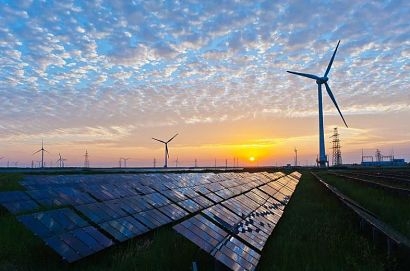
The latest issue of EIA's Electric Power Monthly (with data through September 30, 2020), reveals that wind accounted for 7.9 percent of US electrical generation during the first nine months of 2020, with solar providing another 3.4 percent. By comparison, natural gas provided 40.6 percent.
However, in what may prove to be a harbinger of things to come, the increase in new electricity from wind and solar was actually greater than the increase in electrical generation by natural gas. That is, during the first three-quarters of 2020, solar and wind increased their electrical generation by 45,285 gigawatt-hours (GWh) compared to the same period in 2019.
By comparison, electrical generation by natural gas increased by only 45,254 GWh. While it continued to provide the largest of the nation's electrical output, natural gas grew by only 3.8 percent during the first nine months of 2020 and actually dropped by 5.5 percent in the month of September. On the other hand, wind grew by 12.2 percent and solar by 22.1 percent.
The trend is even more obvious when one compares EIA's most recent electrical generation data with that which it issued five years earlier. Over the past half decade, electrical generation by wind has increased by 80.0 percent while that from solar is more than triple what it was in September 2015. In contrast, electrical generation by natural gas has also increased - but by only 23.6 percent.
Wind and solar are projected to further narrow the gap with natural gas over the next three years as new wind and solar capacity greatly exceed that of natural gas.
According to the latest issue of FERC's monthly Energy Infrastructure Update (with data through 31st October 31), all new US electrical generating capacity for the prior five months (i.e., June - October) was from wind and solar plus a small amount of hydro. There was no new capacity from natural gas. Year-to-date, new capacity from wind alone (6,047 MW) exceeds that of gas (6,039 MW) while utility-scale solar has added another 5,430 MW.
Moreover, wind and solar's share of US total available installed generating capacity continues to increase. Five years ago (i.e., October 2015), wind's share was 5.99 percent; it is 9.27 percent today. Solar's share a half-decade ago was 1.15 percent; today it is 4.09 percent. Combined, wind and solar have expanded their share of generating capacity from 7.14 percent to 13.36 percent - an increase of 6.22 percent. Natural gas has also widened its share of the nation's generating capacity but has only grown from 42.85 percent in 2015 to 44.52 percent in 2020 - an increase of just 1.67 percent.
Over the next three years - by October 2023, FERC projects that natural gas will add a net of 21,575 MW in new generating capacity (i.e., "high probability additions" minus "retirements"). By comparison, wind will add 27,383 MW and solar will add 32,784 MW. As a consequence, natural gas' share of total available installed generating capacity will shrink a bit to 44.44 percent while wind grows to 11.07 percent and solar increases to 6.53 percent (or 17.60 percent combined, up from 13.36 percent today).
However, critics have noted that the average capacity factor for combined cycle gas turbines (54.94 percent over the past five years) has been significantly higher than that for both wind (34.04 percent) and solar PV (25.10 percent). Therefore, estimates for new electrical generation cannot be accurately gleaned simply by making side-by-side comparisons of capacity additions for competing technologies.
To get an apples-to-apples or equivalency comparison of likely new generation from each of the three sources, adjusting capacity by their respective capacity factors yields: gas - 11,853 MW; wind - 9,321 MW; and solar - 8,229 MW. Thus, electrical generation by new utility-scale wind plus solar capacity additions should be roughly 50 percent greater than that from gas.
In fact, new solar electrical generation will actually be higher inasmuch as nearly one-third of solar electricity is currently being provided by distributed, small-scale (e.g., rooftop systems). That suggests that equivalent new solar capacity (utility-scale + distributed) over the next three years could be closer to 12,000 MW -- i.e., more than that of natural gas.
Put differently, actual electrical generation by new solar and wind capacity additions by October 2023 could be nearly double that of new natural gas capacity. As a consequence, while natural gas will still be the largest source of US electrical generation three years hence, wind and solar will be rapidly closing the gap.
"While electrical generation by solar and wind still trail that from natural gas, new renewable energy capacity additions are rapidly closing the gap" said Ken Bossong, Executive Director of the Sun Day Campaign. "And FERC projections for further increases by wind and solar are probably seriously underestimating their near-term growth as prices continue to fall and a far more sympathetic Biden Administration prepares to take office."
For additional information:

